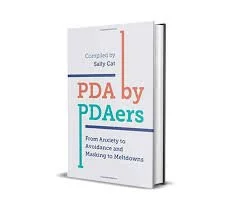Pervasive Drive for Autonomy and Autism
Young child holding a paper map, studying it intently.
Our team of OTs recently met for some professional development, exploring the autistic neurotype called Pervasive Drive for Autonomy (PDA). It was a fascinating conversation, led by OTs Emma & Kristina who are seeing this presentation in more and more of their clients and families.
PDA versus Demand Avoidance
PDA is used to describe a neurotype which co-occurs with autism spectrum disorder. It results in a pattern of behaviors in which real or perceived loss of autonomy leads to an extreme stress response. When we use “Pervasive Drive for Autonomy”, instead of language like “oppositional behaviors” or “pathological demand avoidance” we are acknowledging it as a nervous system disability rather than willful behavior.
Neurodiversity Affirming
At Larchwood Nature OT and Davis OT we use neurodiversity affirming treatments and language. We are not looking to change a person or make them compliant but rather we are seeking creative ways to accommodate their disability within all their environments.
What does PDA look like?
PDA has 3 distinct characteristics:
Equalizing
Fight/Flight/Freeze
Burnout
A child with PDA will try to gain back control in situations where there is a perceived loss of control. This can be with a parent, teacher, therapist, older sibling, etc. If there is a sense of lack of control this will lead to an extreme stress response of fight, flight or freeze. Over time these responses build and result in burnout that looks like intense fatigue and the inability to participate in even the most basic activity of daily living.
How can we work with PDA?
There are a number of ways that you can support the child or adult in your life that has PDA.
Lower demands on them: This may mean shifting your expectations on what it means to be a child, parent or therapist. Demands are what triggers the nervous system to go awry so being thoughtful about what that looks like at home or in the classroom.
Provide control: Allow for choice, child-led activities and make them feel safe.
Increase recovery time: Build downtime in as much as possible to conserve energy and allow the nervous system to rest.
Want to learn more?
You can book a Parent Coaching session with OT Emma and learn so much more, plus be able to implement some new strategies.
Head to the following websites:
Check out these books recommended by OT Kristina:
In an effort to be more neurodiversity affirming, a new autistic neurotype is becoming more widely recognized. Pervasive Drive for Autonomy is a nervous system disability triggered by a person’s real or perceived lack of autonomy. The reaction to this sensation is an extreme stress response and possible burnout. It’s important for therapists, parents and teachers to understand this cycle and make efforts to accommodate their child’s unique needs.



